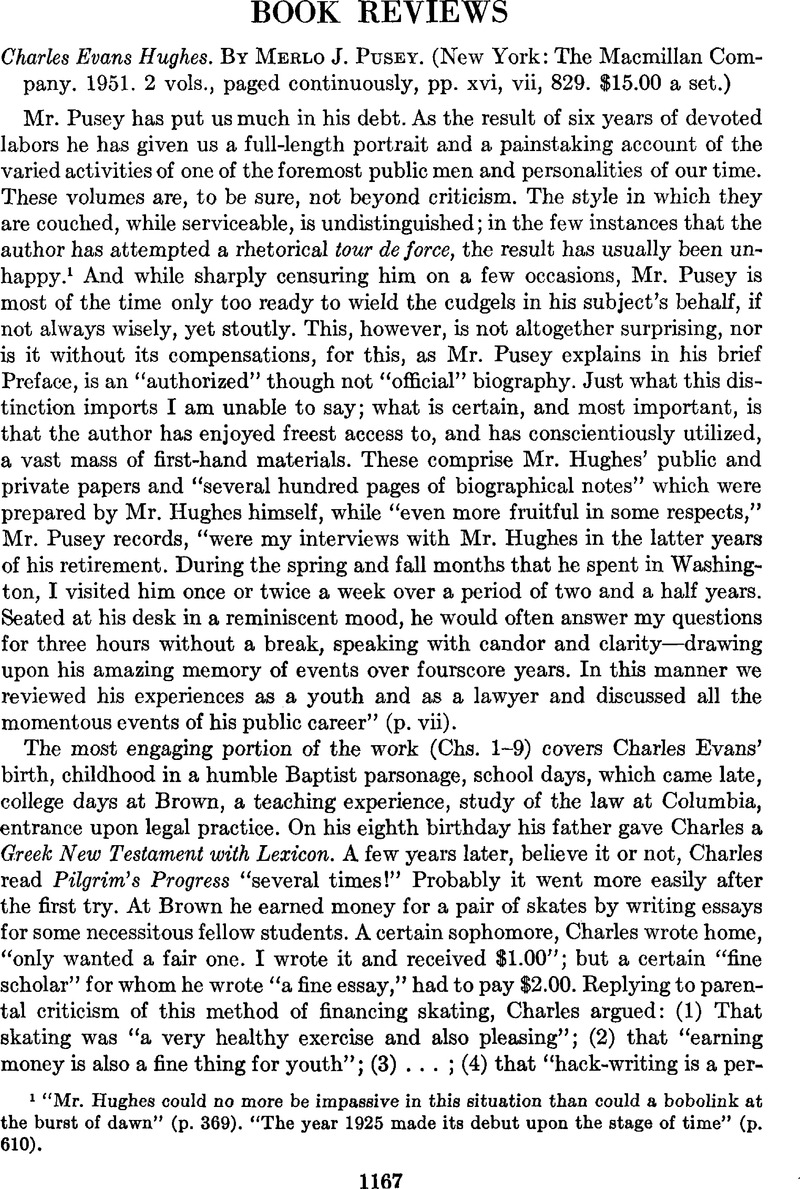No CrossRef data available.
Article contents
Charles Evans Hughes. By Merlo J. Pusey. (New York: The Macmillan Company. 1951. 2 vols., paged continuously, pp. xvi, vii, 829. $15.00 a set.)
Published online by Cambridge University Press: 02 September 2013
Abstract

- Type
- Reviews of Books
- Information
- Copyright
- Copyright © American Political Science Association 1952
References
1 “Mr. Hughes could no more be impassive in this situation than could a bobolink at the burst of dawn” (p. 369). “The year 1925 made its debut upon the stage of time” (p. 610).
2 The two center ones were apparently artificial. (See pp. 16, 17.) Incidentally, Mr. Pusey is in error in suggesting that safety razors were not in use in 1890. The “Star Safety” was put on the market by Kampfe Bros, of New York City in 1880. See Kane, Joseph N., Famous First Facts (New York, 1950), p. 387Google Scholar.
3 The impression arises in part from the appearance in these pages of certain productions of the Hughes pen which were intended only for the family circle. See passim.
4 The late President Hibben of Princeton University told me this anecdote. At a meeting of the Board of Trustees it became necessary for him to designate a member of the Board to confer with Mr. Hughes, then Secretary of State. Turning to Trustee X, Mr. Hibben said, “I think you are the person among us who is nearest to Mr. Hughes, aren't you?” “Yes,” said Mr. X, “I presume I am, but the intervening distance is entirely filled with ice!”
5 The Blumenthal Lectures for 1927 (Columbia University Press, 1928)Google Scholar.
6 National Labor Relations Board v. Jones & Laughlin Steel Corp., 301 U. S. 1 (1937).
7 Schechter Bros. v. U. S., 295 U. S. 495 (1935).
8 United States v. E. C. Knight Co., 156 U. S. 1 (1895); see also Oliver Iron Co. v. Lord, 262 U. S. 172, 178–9 (1923).
9 295 U. S. at 548.
10 Carter v. Carter Coal Co., 298 U. S. 238 (1936).
11 Ibid., 307–9.
12 Ibid., 318–9.
13 301 U. S. at 37.
14 Ibid., 41.
15 Pusey calls Jones-Laughlin Corporation an “octopus”—a term hardly applicable to either the clothing or the trailer company. See pp. 758–9.
16 This occurred in United States v. Darby, 312 U. S. 100 (1941).
17 The Court and the Constitution (Harvard University Press, 1951), p. 56Google Scholar.
18 297 U. S. 1, 78 (1936).
19 298 U. S. at 324 ff.
20 ProfessorMason, Alpheus T., “Harlan Fiske Stone and FDR's Court Plan”, Yale Law Journal, Vol. 61, pp. 791, 813 (June, 1952)CrossRefGoogle Scholar.
21 Even now we have a much more satisfactory account and evaluation of Justice and Chief Justice Hughes' work in the field of constitutional interpretation than Mr.Pusey's, , in Hendel's, SamuelCharles Evans Hughes and the Supreme Court (Crown's Press, Columbia University, 1951)Google Scholar.
22 Some Hughes off-the-bench constitutional views are the following: Coolidge became President the moment Harding died, and took the oath of office as President (p. 563); “Whatever is pertinent to our international relations … is within the sweep of the power to make treaties” (Mr. Pusey's words, p. 612); “The House has no right to inquire into a treaty that requires ratification of the Senate only” (p. 415). I should endorse the first two of these statements, but not the third. The House may inform its judgment as to anything requiring legislative action. Most treaties require at least an appropriation to carry them out, and all treaties are subject as law of the land to repeal by Congress.
It was in 1907 that Mr. Hughes “uttered his most frequently quoted phrase,” says Mr. Pusey, “… The Constitution is what the judges say it is.” Mr. Pusey continues: “Through the remainder of his life he was to hear and see this casual phrase, torn from the context of an extemporaneous speech, repeated again and again as if he had, in a moment of candor, exposed the solemn function of judging as a sort of humbuggery. Of course he had done nothing of the sort. ‘The inference that I was picturing constitutional interpretation by the courts as a matter of judicial caprice,’ he wrote in his Biographical Notes, ‘… was farthest from my thought. I was not talking flippantly or in disrespect of the courts, but on the contrary with the most profound respect. I was speaking of the essential function of the courts under our system in interpreting and applying constitutional safeguards, and I was emphasizing the importance of maintaining the courts in the highest public esteem as our final judicial arbiters and the inadvisability of needlessly exposing them to criticism and disrespect by throwing upon them the burden of dealing with purely administrative questions’” (p. 204). I doubt if Mr. Hughes had a very substantial case against those who thus quoted him “out of context.” It seems to me that in the above phrase, which stands very well by itself, he gave a rather realistic description of the power of judicial review as exercised by himself on certain occasions. These furnish it ample context. Besides, when an important man speaks or writes quotably on an important topic, he must expect to be quoted, whether out of context or otherwise. It is one of the risks of the trade. Sir Frederick Pollock has some sensible remarks on the subject in one of his letters to Holmes.





Comments
No Comments have been published for this article.